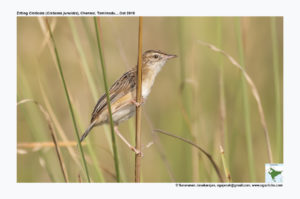Zitting Cisticola

Zitting Cisticola Cisticola juncidis
Etymology:
- Cisticola : Greek word kistos –shrub; cola – dweller
- Juncidis : Latin word for “ Reed”
Vernacular Names: Hindi: Ghas ki-phutki/pitpiti, Pun: Chhoti dharidar piddi, Bi: Khergusa, Monghyr: Tuntunia, Guj: Ghasni fudki, Nani pan-tiktiki, Ta: Tinu-kuruvi, Vayalan, Te: Yerdu/Yedru jitta, Mal: Potappottan, Sinh: Tanacola-kurulla, Mar: Reshal Vatvatya
Distribution in India: Wide spread resident in India except North West of India
Description: Size of 10–14 cm; wt. of male, female 5–8 g. It is a small Cisticola with a medium-short, rounded tail and streaked upperparts. The male of nominate race in breeding has plain buffy face, with creamy lores and eyering extending into paler supercilium, rufous-washed cheek and side of neck. It is buffy or rufous-brown above, heavily streaked blackish brown on crown, mantle, back and uppertail-coverts, rump is almost plain, darker above in worn plumage, when crown may appear almost all black. The flight-feathers are dark brown with buff margins; upperwing-coverts are blackish with broad buff margins. The tail is dark brown, edged rufous-brown, with blackish subterminal band and prominent white tips when fresh. It is creamy buff below, paler on throat and central belly, rich cinnamon-buff on flanks and vent. The iris is pale brown; bill is dark grey, paler base, mouth is black. The legs are pinkish-flesh. The non-breeding male is more finely streaked on crown, contrast between dark cap and paler nape are reduced; tail is slightly longer, with narrower feathers more broadly edged buff-brown. The bill is pinkish-horn with dark brown culmen ridge, mouth is pinkish. The breeding female is more finely streaked above than the breeding male, and has duller brown feather margins, more buffy underparts; non-breeding female is like male. The juvenile is like non-breeding adult but more rufous above, with broad, duller brown streaking, including on rump; gape is yellowish, eyes are duller and legs are paler pink. Some early-fledged males acquire black mouth after only two months. Three races found in India, race cursitans ( Widespread except in South West India) is brighter and warmer buff than nominate, with buffy tail mirrors; race salimalii ( South West India ) is darker and more richly coloured; race malaya ( Nicobar Island) is smaller and more richly coloured, lacks seasonal plumages in some areas.
Habitat: It is found in Open grasslands, including seasonally flooded and grassy wetlands, meadows, fallow lands and cultivated croplands. Prefers some bare ground for foraging, but breeding pairs require live, narrow-bladed grasses, sedges or plants with similar structure for nest-sites
Food Habits: It eats small invertebrates, chiefly insects and their larvae, and small spiders, also eats flower nectar. Usually singly. It forages among reeds or tall grasses, threading its way with ease as it climbs through the vegetation. It also forages on ground, gleaning prey from bases of grass tufts; also low down in grass or forbs, searching leaves; occasionally hawks insects in air.
Breeding Habits: They breed in April-July. Male attracts female to nest-site by flying in pendulum flight over her, guides her in zigzag flight to site, then circles 1 m above her with rapid wingbeats, while giving soft “pyr” calls. Nest built by male in 2–3 days, a vertical, pear-shaped “soda-bottle”, with top entrance facing slightly away from prevailing winds, fashioned from 20–80 live vertical grass leaves bound together with spider web and plant down, sometimes leaves stitched together with spider web or plant down; up in dense tuft of living grass, height increasing as season progresses and grasses grow taller. Once a female selects a nest she lines it with plant down, fine dry grass, cobwebs and occasionally wool, taking 1–4 days , only one nest used for courting at any time, male starts new courtship nest as soon as a female accepts existing one or if latter not used after 6–7 days. It lays a clutch of 4-6 eggs. Incubation from final or penultimate egg, by female only, males feed female at nest. The incubation period is 11–15 days. The chicks fed by female only, nestling period 11–15 days. The young will be fed by female for 10–20 days after leaving nest.